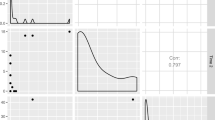Abstract
When comparing two independent groups, there is now a substantial literature on characterizing the difference between the groups using a measure of effect size that is based on a measure of location in conjunction with some measure of dispersion. Included is a measure of effect size that allows heteroscedasticity. This paper suggests a robust extension of this heteroscedastic measure of effect size to situations where there is a covariate. A method for making inferences about the proposed measure of effect size is described and studied via simulations. The proposed method is illustrated with data dealing with the wellbeing of older adults.




Similar content being viewed by others
References
Algina, J., Keselman, H. J. and Penfield, R. D (2005). An alternative to Cohen’s standardized mean difference effect size:, A robust parameter and confidence interval in the two independent groups case. Psychological Methods 10, 317–328. https://doi.org/10.1037/1082-989X.10.3.317.
Bradley, J. V. (1978). Robustness? British Journal of Mathematical and Statistical Psychology 31, 144–152. https://doi.org/10.1111/j.2044-8317.1978.tb00581.x.
Clark, F., Jackson, J., Carlson, M., Chou, C.-P., Cherry, B. J., Jordan-Marsh, M., Knight, B. G., Mandel, D., Blanchard, J., Granger, D. A., Wilcox, R. R., Lai, M. Y., White, B., Hay, J., Lam, C., Marterella, A. and Azen, S. P. (2012). Effectiveness of a lifestyle intervention in promoting the well-being of independently living older people: results of the Well Elderly 2 Randomise Controlled Trial. J. Epidemiology Community Health 66, 782–790. https://doi.org/10.1136/jech.2009.099754.
Cohen, J. (1988). Statistical Power Analysis for the Behavioral Sciences, 2nd Ed. Academic Press, New York.
Efron, B. and Tibshirani, R. J. (1993). An Introduction to the Bootstrap. Chapman & Hall, New York.
Hampel, F. R., Ronchetti, E. M., Rousseeuw, P. J. and Stahel, W. A. (1986). Robust Statistics. Wiley, New York.
Huber, P. J. and Ronchetti, E. (2009). Robust Statistics, 2nd Ed. Wiley, New York.
Hochberg, Y. (1988). A sharper Bonferroni procedure for multiple tests of significance. Biometrika 75, 800–802. https://doi.org/10.1093/biomet/75.4.800.
Koenker, R. and Bassett, G. (1978). Regression quantiles. Econometrika 46, 33–50.
Kulinskaya, E., Morgenthaler, S. and Staudte, R. (2008). Meta Analysis: A guide to calibrating and combining statistical evidence. Wiley, New York. https://doi.org/10.1348/000711005X68174.
Kulinskaya, E. and Staudte, R. G. (2006). Interval estimates of weighted effect sizes in the one-way heteroscedastic ANOVA. Br. J. Math. Stat. Psychol 59, 97–111. https://doi.org/10.1348/000711005X68174.
Rousseeuw, P. J. and Leroy, A. M. (1987). Robust Regression & Outlier Detection. Wiley, New York.
Sen, P. K. (1968). Estimate of the regression coefficient based on Kendall’s tau. J. Am. Stat. Assoc 63, 1379–1389. https://doi.org/10.2307/2285891.
Staudte, R. G. and Sheather, S. J. (1990). Robust Estimation and Testing. Wiley, New York.
Theil, H. (1950). A rank-invariant method of linear and polynomial regression analysis. Indagationes Mathematicae 12, 85–91.
Tukey, J. W. (1960). A survey of sampling from contaminated normal distributions. Stanford University Press, Stanford. Contributions to Probability and Statistics, Olkin, I., Ghurye, S., Hoeffding, W., Madow, W. and Mann, H. (eds.), p. 448–485.
Wilcox, R. (2016). ANCOVA: A Global Test Based On a Robust Measure of Location or Quantiles When There Is Curvature. J. Mod. Appl. Stat. Methods 15, 1.
Wilcox, R. R. (2022). Introduction to Robust Estimation and Hypothesis Testing, 5th Edition. Academic Press, San Diego.
Yohai, V. J. (1987). High breakdown point and high effciency robust estimates for regression. Ann. Stat 15, 642–656. https://doi.org/10.1214/aos/1176350366.
Author information
Authors and Affiliations
Corresponding author
Additional information
Publisher’s Note
Springer Nature remains neutral with regard to jurisdictional claims in published maps and institutional affiliations.
Rights and permissions
About this article
Cite this article
Wilcox, R.R. ANCOVA: An Approach Based on a Robust Heteroscedastic Measure of Effect Size. Sankhya B 84, 831–845 (2022). https://doi.org/10.1007/s13571-022-00291-4
Received:
Accepted:
Published:
Issue Date:
DOI: https://doi.org/10.1007/s13571-022-00291-4




